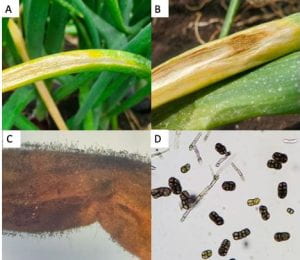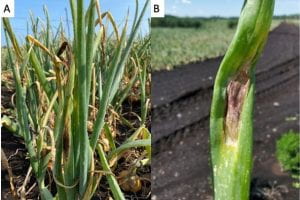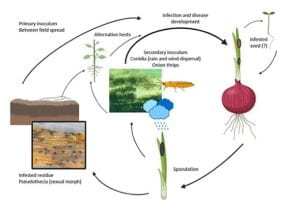Printer-friendly .pdf version of this factsheet
Pathogen
Stemphylium leaf blight (SLB) is caused by the fungal pathogen Stemphylium vesicarium.
Hosts
SLB primarily affects members of the genus Allium, such as onion, garlic, leek, and shallot but other crops can also be affected, such as asparagus, sunflower, parsley, radish, European pear, mango, tomato, and soybean.
Significance
SLB has recently become a re-emerging disease in the northeastern United States, being one of the most common foliar diseases affecting onions. SLB is primarily observed on onion leaves, reducing photosynthetic area, which results in smaller and low-quality bulbs. Bulb storage can also be compromised as healthy leaves are required for the uptake of sprout inhibitors, applied to long-term storage cultivars prior to harvest and once bulbs are mature.
Symptoms
SLB symptoms begin as small yellow spots that enlarge into ovate-elongate lesions with tan to brown colors (Fig. 1A). Lesions may be water-soaked and can occur across the leaf but have a tendency to occur on the leaf tips. Lesions can coalesce and result in necrotic leaf dieback and blighting (Fig. 2A). As lesions age, centers usually become dark olive brown to black due to the profuse production of reproductive structures of S. vesicarium, including asexual spores (conidia) (Fig. 1B, 1C, 1D and Fig. 2A). SLB symptoms can be mistaken with other foliar diseases, such as purple blotch caused by Alternaria porri. Purple blotch lesions also begin as water-soaked spots, but older lesions are elliptical in shape with a target appearance and typically magenta pink-purple in color (Fig. 2B).


Disease Cycle
SLB epidemics may be initiated by primary inoculum coming from infested crop residue or alternative hosts (neighboring crops or weeds). Alternative hosts include weeds commonly found in onion crops, such as nutsedge, pigweed, purslane, bull thistle, sow thistle, marshcress, horsetail, jimson weed, and field pennycress. Additional sources of S. vesicarium inoculum have been proposed also to initiate SLB epidemics, including infested seeds, volunteers (plants from the previous season that remain in the field), and transplants. Within the cropping season, conidia of S. vesicarium can be spread by wind, rain splash, or thrips resulting in the infection of healthy leaves. Warm temperatures between 60-80°F and wet conditions leading to extended leaf wetness are favorable for infection and disease development.

Disease Management
Strategies to control SLB involve cultural and chemical practices that are targeted to reduce the initial inoculum and the rate of disease progress.
Cultural control:
- The use of certified seed or disease-free transplants is crucial to reduce the probability of introducing S. vesicarium.
- Removal or burying of crop residues through tillage and crop rotation with non-host crops for at least 1 year may help reduce S. vesicarium inoculum between cropping seasons.
- Optimization of weed control within and surrounding onion fields earlier in the season may help remove green bridges for inoculum.
Chemical control:
- Foliar application of fungicides that are registered for use in onion to control SLB in NY may help reduce within-season epidemic progress. Registered fungicides fall into five different fungicides groups based on their mode of action: quinone outside inhibitors (Fungicide Resistance Action Committee-FRAC group-11), demethylation inhibitors (FRAC 3), dicarboximides (FRAC 2), succinate dehydrogenase inhibitors (FRAC 7), and anilino-pyrimidines (FRAC 9).
- However, laboratory assays have identified resistance in NY S. vesicarium populations to azoxystrobin and pyraclostrobin (FRAC 11), boscalid (FRAC 7), and cyprodinil and pyrimethanil (FRAC 9). Ongoing research at Cornell AgriTech, Geneva, NY, revealed that the proportion of S. vesicarium isolates with reduced sensitivity to tebuconazole (FRAC 3) has increased between 2018 and 2021 in populations from Wayne Co., Oswego Co., Orange Co., and Elba region. Reduced sensitivity to iprodione (FRAC 2) has also been found in S. vesicarium, but further research is necessary to corroborate preliminary results. Due to the rapid evolution of fungicide resistance in NY, fungicide programs for SLB have been updated on an annual basis by Cornell Co-operative Extension. Check out our Cornell Onion Fungicide “Cheat Sheet” for Control of Leaf Diseases in New York, 2022.
- Fungicides in other FRAC groups, including FRAC 12 and multi-site mode of action M3 and M5, have been shown to have limited efficacy against SLB.
Further information:
Dr. Sarah J. Pethybridge (sjp277@cornell.edu)
Cornell AgriTech
211 Barton Laboratory
Geneva, New York
(315) 744-5359 (cell)
Dr. Frank Hay (fsh32@cornell.edu)
Cornell AgriTech
120 Barton Laboratory
Geneva, New York
(315) 413–9083 (cell)
Dr. Daniel Heck (dwh237@cornell.edu)
Cornell AgriTech
A122 Barton Laboratory
Geneva, New York
(315) 878-1314 (cell)


